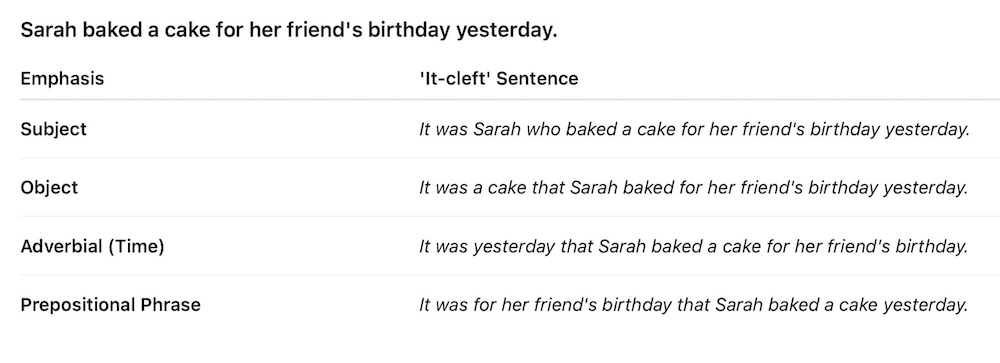- Home
- Grammar Lessons
- Punctuation Rules
Basic Rules of Punctuation in English
In this lesson you'll learn the basic rules of punctuation in English.
Punctuation is a vital component of writing, ensuring clarity and precision in communication. Whether you are a learner of English or simply looking to refine your writing skills, understanding the rules and guidelines of punctuation is crucial.
This guide provides the basic rules with examples to help you master the use of various punctuation marks.
- Apostrophes
- Brackets
- Commas
- Colons
- Semi-colons
- Hyphens
- Dashes
- Quotation Marks
- Ellipses
- Exclamation Marks
- Question Marks
- Periods / Full-stops
Apostrophes
Let’s start with apostrophes.
One use of apostrophes is to indicate possession/ownership. To do this, we place an apostrophe before an 's', though it appears after in the case of plural nouns or words already ending in 's'.
Possession
- John's book is on the table. (possession for singular noun)
- A week's worth of groceries. (showing time duration in possession)
- The children's playground is newly renovated. (possession for plural noun not ending in 's')
- My parents' marriage was in 1955 (possession for plural noun ending in 's')
- The Jones' house is beautiful (word already ending in 's')
The other common usage is to show letters have been omitted - in other words, to create contractions.
Contractions
- It's going to rain soon. (contraction of "it is")
- I can’t find my keys. (contraction of "cannot")
- He's taken it. (contraction of "he has")
Apostrophes thus help clarify the meaning of sentences by showing ownership or contractions.
Brackets / Parentheses
Brackets can be either round () or square [].
Round brackets, or parentheses (US English), are used to include additional information.
Round Brackets
- The event (scheduled for next Monday) has been postponed due to bad weather (clarification or additional Information)
- According to Smith (2005), the trend is expected to continue. (In-text citations)
- I need to buy milk (and maybe bread), but not eggs. (additional items in a list)
- Please solve this equation: 2×(3+5). (mathematical expressions)
- Please submit your form(s) along with a photocopy of your ID. (to show possibility of singular or plural)
Square brackets are used for explanatory purposes within quoted text.
So in some respects, they can have a similar role to round brackets, it just depends on whether the text is quoted or not.
Square Brackets
- "She [Alice] said she would arrive at 3 o'clock." (adding to clarify)
- "Hopefully I can repair [the car]" (replacing to clarify - the text in brackets replaces "it")
- "He arrived their [sic] at 6pm" ('sic' shows the incorrect spelling - 'their/ere' - was from the original text)
- "He start[ed] studying yesterday" (making the sentence fit grammatically)
- "Gentrification as a process [...] can cause significant disruption" (showing some text from the original source has been omitted)
Commas
Now, let's discuss commas, which perhaps are the most commonly used and misused punctuation marks. Commas indicate a pause between elements in a sentence or separate items in a list.
- I bought apples, oranges, bananas, and grapes. (list separation)
- Well, it’s about time we met. (introductory word)
- My friend, a skilled carpenter, fixed the door. (non-restrictive clause)
- He drove to work, but she took the bus. (separation of clauses)
- Yes, I understand your point. (direct address)
Colons
Colons are used to introduce a list, quote, or explanation. They direct the reader's attention to what follows next.
- There are three issues: cost, time, and scope. (introduction of a list)
- He had only one goal: to win the race. (introduction of a clause)
- Remember this rule: Never run near the pool. (introduction of a rule)
- "In the words of the CEO: 'Strive for excellence.'" (introduction of a quote)
- I have two choices: start over or give up. (summarisation)
Semicolons
One use of semicolons are used to connect closely related independent clauses, before transition words (e.g however, as a result, consequently).
Related Clauses
- I went to the store; I bought some milk.
- She loves cooking; he loves painting.
- We need to order more paper; otherwise, we won’t be able to print the reports.
- I can’t come out tonight; I have too much homework.
Another use of semicolons is to separate items in lists that are complex and/or have other commas. Thus they help to maintain clarity and coherence.
Complex Lists
- The conference has people from Portland, Oregon; Dallas, Texas; and Tampa, Florida.
- The conference will include sessions on effective communication strategies; conflict resolution techniques, particularly in multicultural environments; leadership development programs; and the role of technology in modern business practices.
- For dinner, we had spaghetti with tomato sauce; a Caesar salad, dressed lightly; grilled chicken, marinated in lemon and herbs; and for dessert, a rich, decadent chocolate cake.
Hyphens
Now we'll look at the basic rules of punctuation in English as regards hyphens. These are used to create compound words or to join prefixes (e.g. post, pre; ex, anti) to other words. They are essential in avoiding ambiguity.
- A well-known author visited our school. (compound adjective)
- This is a high-pressure situation. (compound adjective)
- Mother-in-law (compound noun)
- Anti-inflammatory drugs (prefix usage)
- Ex-president (prefix usage)
Dashes
Moving on to the basic rules of punctuation for dashes, these are longer than hyphens and have different uses. They are longer than hyphens.
There is the en dash (–), the length of an 'N', which often represents a range, replacing the word 'to'.
En Dash
- Read pages 10–20 by tomorrow. (range of numbers)
- He was Prime Minister from 1997-2010 (range of dates)
- Flight DT324: Miami-Detroit (directions)
The, em dash (—), the length of an 'M', can replace commas, parentheses, or colons.
Em Dash
- My brother—whom you’ve met before—is coming tonight. (parenthetical/bracket explanation)
- They plan to renovate—the kitchen, the bathroom, and the living room. (list with emphasis)
- Everything was in place—I checked twice. (emphatic pause)
- He won the race—a true miracle! (emphatic addition)
- "Be the change that you wish to see in the world." — Mahatma Gandhi (crediting a quotation)
Some of these are simply used instead of other punctuation e.g. using commas or brackets for extra/additional information.
Quotation Marks
Quotation marks are used to denote speech, quotations, or phrases taken directly from another source. They highlight exact phrases spoken or written by others.
- "Where are you going?" he asked. (direct speech)
- She said, "I'll be there in five minutes." (direct speech)
- "To be or not to be," is one of Shakespeare's most famous lines. (quotation from literature)
- Did he really say, "It's over"? (inquiring about exact words)
- "Wow," she exclaimed, "That's amazing!" (emphasis in speech)
Ellipses
Ellipses are a series of three dots (...). The basic rules of punctuation for ellipses is that they indicate that something has been omitted from a quote or that a thought has trailed off in informal writing.
- “I don’t know… maybe tomorrow.” (thought trailing off)
- “The Constitution...shall be the supreme law of the land.” (omission in direct quote)
- He wondered if she was truly happy... or just pretending. (suspense or trailing thought)
- “When I was growing up in New York... those were the best days,” she recounted nostalgically. (omission of parts of her life)
- “Are they coming... or not?” he pondered aloud. (indicating uncertainty or pause)
Exclamation Marks
Notice the impact of exclamation marks! These are used to express surprise, excitement, or any other strong emotion.
- Watch out! (warning or urgent call)
- I can't believe you did that! (surprise or disbelief)
- That's amazing! (admiration or excitement)
- Finally! (relief or triumph)
- Stop right there! (command or urgent request)
Question Marks
Question marks are primarily used at the end of interrogatives i.e. any sentence that projects inquiry.
- Are you coming with us? (direct question)
- What time is it? (request for information)
- Could that be true? (rhetorical question, implying doubt)
- Do you know how to cook this dish? (inquiry about ability)
- Who decided this was a good idea? (question of decision-making)
Periods / Full Stops
Finally, periods (or full stops) mark the end of declarative sentences, indicating a full stop in the thought or statement.
- I like to read. (simple statement)
- He went to the store. (action statement)
- Please close the door. (command)
- It’s a lovely day. (statement of fact)
- She will arrive tomorrow. (futuristic statement)
Basic Rules of Punctuation - Summing Up
This guide on the basic rules of punctuation in English has hopefully provided a deeper understanding of the nuanced rules and guidelines in the English language.
By mastering the correct use of punctuation, you can enhance the clarity and effectiveness of your communication, whether in academic writing, professional environments, or everyday interactions.
Remember, excellent punctuation doesn't just signify good grammar and attention to detail; it also shows respect for your reader. It ensures that your intent and tone are communicated effectively, leaving little room for misinterpretation.
Happy punctuating!
New! Comments
Any questions or comments about the grammar discussed on this page?
Post your comment here.



